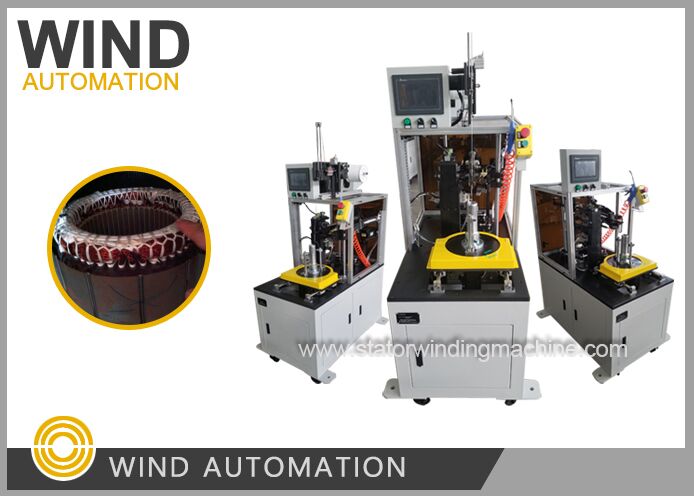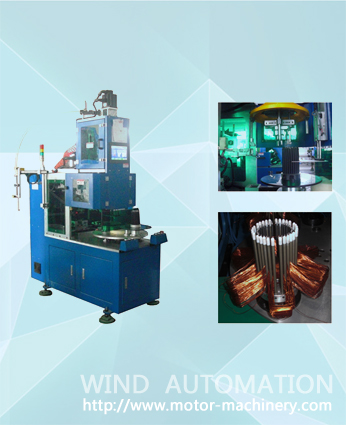CATEGORIES
- Motor machinery for Stator
- Motor machinery for Armature
- Motor machinery for Rotor
- Motor parts
- Heat treatment varnish Oven
- Induction cooker machinery
Latest news
- Motor Manufacturers Clinet visit in th
- Motor Testing equipment in Shanghai Ch
- Motor efficiency improvement is an imp
- Hybrid electric vehicle Hairpins New e
- How to produce a big 12KGS Bruless Mot
- Power Coating For Motor Insulation Ele
Contact us
- ADD: No.4 Building , No.1500, Kongjiang Road,Yangpu District,200093,Shanghai,China Skype: motor.machinery
- TEL: 86-21-58992293
- FAX: 86-21-58992292
- E-mail: sales@motor-machinery.com



Stator coil single side lacing WIND-100-CL
- Product description: Lace and bind the coil end with insulation thread side by side
PRODUCT INTRODUCTION
A stator coil lacing machine apparatus and method which enables the end windings of a stator to be bound together by lacing cord and which automatically ties a knot in the cord at the completion of the cycle to firmly secure the lacing cord in position. This method and apparatus reduces the direct labor necessary to produce the end windings and provides them in an automated and efficient manner.
Stator coil single side lacing machine WIND-100-CL, Parameter:
Thickness of stator lamination: 10mm-100mm
Min stator ID: Φ 35mm
Max coil height: 40mm
Max outer diameter of stator: Φ 160mm
Lacing speed: around 0.7s per slot
Power supply Input: 220V/50Hz,60Hz
Air pressure: 0.5 to 0.8MPa
Dimension: 1000mm × 600mm × 1150mm
Weight: ≈ 600kg
Engineer show the process to motor assembly user:
Contact:Shanghai Wind Automation Equipment Co.,Ltd
Email: emily@motor-machinery.com
Skype: motor.machinery
Mobile: +86-18067425780
Website: http://www.motor-machinery.com; http://www.coilswinding.com
Stator lacing is the process of tightly securing the field coil ends of an electric motor stator with a stitched cord,motor stator braiding. Lacing is typically used on long-life-expectancy or high-efficiency motors such as some induction motor where the cost of failure is high. Generally, low-cost “throwaway” motors are not laced. There are several reasons for lacing motor stators:
• The lacing holds the thermal protector, coil ends, and leads in the proper position.
• Lacing extends a motor’s life by preventing the wires in the coils from vibrating and causing fatigue failure during operation.
Lacing may be used to hold the coils in position and provide loops to hang the stator from a conveyor during the dip-and-bake varnishing operation.
The most obvious reason for lacing a stator automatically by machine is increased productivity. The lacing machine can lace more stators per hour than a person doing it manually, and usually at a substantially lower cost. The lacing machine also provides improved lacing quality and consistency over long time periods.
Another important advantage of machine lacing is the avoidance of carpal tunnel syndrome, a debilitating hand and wrist injury caused by repetitive strenuous handwork.
Several different styles of lacing machines are generally available to the motor manufacturer. The simplest machines lace one end of the stator at a time, and are referred to as single-end lacers. Others have two needles and lace both ends of the stator at the same time, and are known as double-end lacers.
Lacing machines may be constructed so the stator is vertical and the lacing needle is horizontal, or with the stator horizontal and the lacing needle vertical.
Most lacing machines index the stator about its axis during the lacing cycle, but a few machines have been designed to clamp the stator and rotate a lacing head with the needle around the stator.
Some machines use a closed needle with an eye, like a sewing machine, but the vast majority use an open needle, similar to a crochet hook, to form the stitch. In general, the open-hook needle produces a “diamond” stitch, with diagonal coverage of the coils, whereas the closed-eye needle produces more of a radial stitch.
There is also a wide variety of lacing cords (insulation thread) available. These cords may be made from fibers such as cotton, polyester, nylon, or other synthetics, and may be formed





 Pearl
Pearl Emily
Emily